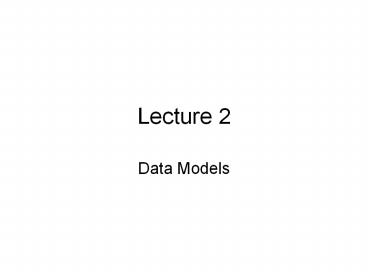Data%20Models - PowerPoint PPT Presentation
Title:
Data%20Models
Description:
Lecture 2 Data Models Learning Objectives Why data models are important About the basic data-modeling building blocks What business rules are and how they affect ... – PowerPoint PPT presentation
Number of Views:115
Avg rating:3.0/5.0
Title: Data%20Models
1
Lecture 2
- Data Models
2
Learning Objectives
- Why data models are important
- About the basic data-modeling building blocks
- What business rules are and how they affect
database design - How the major data models evolved, and their
advantages and disadvantages - How data models can be classified by level of
abstraction
3
- Data model
- Models abstraction of real-world Events
- DB Model
- Represents data structure and relationship
- Conceptual
- "What" is represented
- Implementation
- "How" represented
4
CONCEPTUAL
- 3 types of associations
- ..one to many
- ..many to many
- ..one-to-one
5
Implementation
- How data is represented in database ?
6
Types of Data Models
- Hierarchical (see page 33)
- Network (see page 34)
- ..Simple
- ..Complex
- Relational (page 36)
- Object-Oriented (page 41)
7
Hierarchical DB Model
- ex IMS by IBM
- basic unit is SEGMENT
- (similar to a record)
- root
- ..a child can have at the most one parent
- ..a parent can have many children
- navigation path
- .pre order traversing
- .post order traversing
8
Advantages/Disadvantages
- Advtg
- allows data sharing
- data independence
- data integrity
- efficient for
- DISADVTG
- need to know some PHYSICAL level details
- data that do not conform to 1m
- complex and less flexible
- need to provide navigational path
- ad-hoc capabilities limited
9
Network DB model
- SET
- OWNER and MEMBERS
10
Advantages/Disadvantages
- Advantages
- .mn easy to implement
- .data integrity is maintained
- .data independence
- Disadvantages
- .Complex
- .no structural independence
- .navigation path
11
Relational Model (p 36)
- Linking relational tables (page 37)
- Typically done through primary and foreign key
- Read the examples carefully
12
Object-Oriented Model (page 41)
- Objects are defined (similar to entities)
- Objects contain data and procedures
- Objects can FIT with other objects
- Objects are reusable
- Objects have INHERITANCE property
13
ER Data Model (page 38)
- Define
- Entities
- Attributes
- Relationships
14
Degree of DATA abstraction
- Conceptual IT (hardware/software independent)
- Internal (DBMS dependent)
- External (end user orientation)
- Physical Model (actual implementation)
15
- Supplemental reading
- www.itpapers.com































